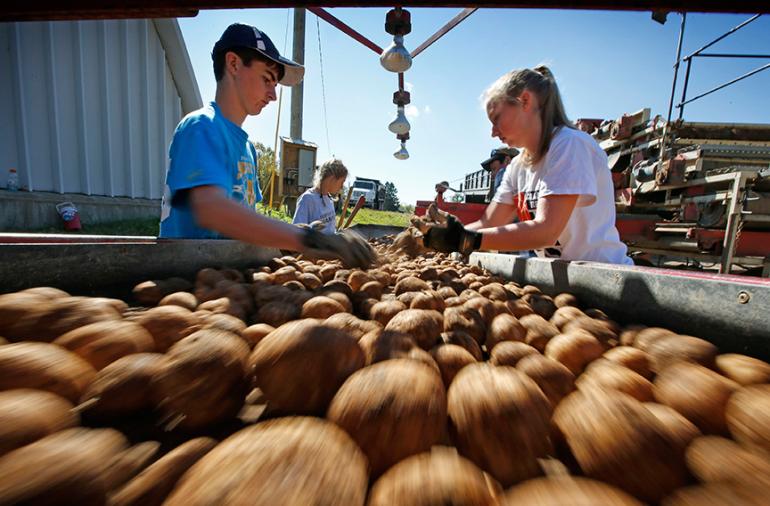Picking Winners
WANTED: POTATO HARVESTERS FOR FALL SEASON. That’s what the classified job posting says. What I interpret is “curious person to play John Steinbeck character for awhile.” I immediately accept my idealized job description.
I imagine the first day of work—frolicking across acres of golden-brown fields like Laura Ingalls Wilder, though instead of wearing a pioneer dress and braids I’m bearing Carhartts and pigtails. The sun high overhead and a cool breeze in the air, I pluck potatoes from the dry earth and plop them into an off-white sack. There are fingerprints of soil, remnants of the earth spread across the outside of the bag. It’s a beautiful daydream—while it lasts.
I park my truck in front of the large pull-barn and catch a glimpse of my Idaho license plate: “World Famous Potatoes.” I laugh at the irony since I’m in Manhattan, potato capital of Montana. I wonder how many people in the valley realize these potato fields exist in the area.
Instead of being emancipated into the fields with a plot map and compass, I’m led inside a huge trailer. A heap of potatoes whirl by below my nose across a conveyer belt. There are clanks and crashes, sounds typical of a factory. My mind immediately regresses to my first factory experience at the age of 15 where it was my job, literally, to place little round pegs into square holes. Three months later I wonder why I keep showing up for work. Perhaps it’s the same reason I keep riding the greyhound bus after vowing never again to put myself through such torture.
It’s mid-January. We’re in washing season now, which comes after harvesting. After washing is planting (April) followed by irrigation (June through August), then tilling in October and back into harvest by the end of September.
Although this particular phase is called washing, what we’re really doing is sorting potatoes by their size and picking out the green ones so they don’t end up in the grocery cart of an unsuspecting Safeway patron. There’s a large heap of these Russet Burbank potatoes in the back of the warehouse, stored at 38 degrees, which is the optimal temperature to avoid rotting. They’re piled up to the ceiling, and one misplaced tug could cause a potato avalanche.
I suspect many people would think the Gallatin Valley unsuitable land for potato farming, though surprisingly there are 26 potato seed growers in the valley with a cumulative acreage of 3,697, making this the largest area of potato seed farmland (in terms of acreage) in Montana. The Gallatin Valley has rich soil and the surrounding mountains ward diseases common to other farmlands like the potato beetle and scab.
The commercial potatoes we’re sorting today are actually a byproduct of the main industry—the potato seed. Averaging 10 ounces and above, these particular potatoes are too large to be sold as seed potatoes. They’ll be shipped to Sysco in Billings and distributed to restaurants and grocers.
Ron, my boss and the owner of Wataview Farm, sells the potato seed to other farm owners in Washington, Minnesota, and the Dakotas who then plant them for commercial farming. There are no commercial potato growers in Montana—only seed growers.
The saying “reap what you sow” should really be “reap what someone else sows”, since it’s customary for farmers not to plant their own seeds for a season’s crop. A seed from another’s soil is less prone to disease, resulting in higher yields. Ron buys his seed potatoes from other farmers at generation two (3 years of growth) and sells them a year later to other farmers as generation three seeds. Most Montana growers stop growth around generation four since our season is too short to produce them past that stage.
The factory is a damp cold. With one’s eyes closed, the sounds could be mistaken for that of a bowling alley. There are 12 of us positioned around the belt, five men packaging and bagging the potatoes, and one unlucky potato washer (nicknamed the swamper) whose work uniform includes head-to-toe raingear to deflect the water while he sprays the mud off of the spuds.
Take away the conveyer belt and it’d look like we’re pantomiming at high speed as we slam-dunk the spuds into their proper bins by size. The potatoes whirl by so quickly that nausea sets in and they begin to transform into a mirage of speckled wallpaper, or miniature loaves of bread. We’ve all come to Wataview seed farm for various reasons. For some of us, it’s a manageable transition back into society after an earth-shattering event like a divorce, or renunciation from an addiction. For others, well, we misinterpreted the classified ad. But perhaps for all of us it fulfills something deep within: the ability to lend a hand to a local farmer, so we can continue to stave off the encroachment of corporate farming for at least a little while longer.






